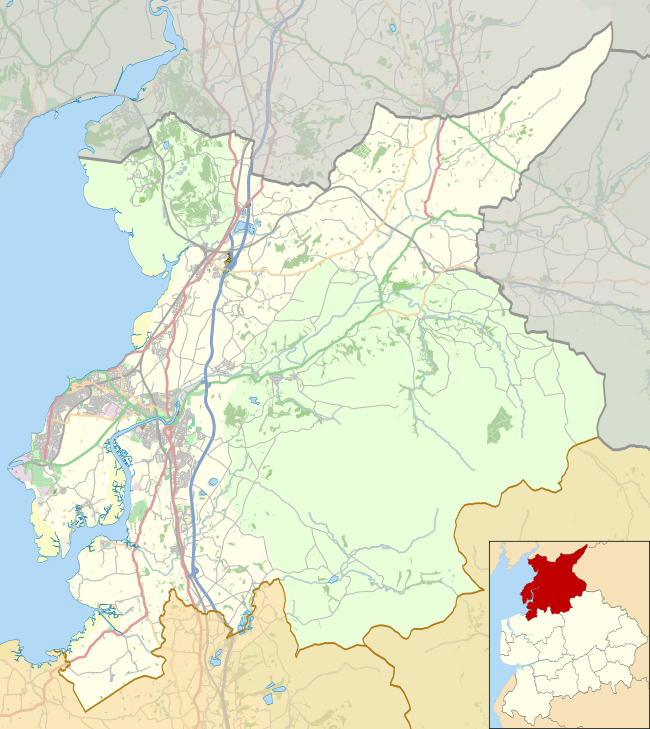St Michael's Church, Whittington
| St Michael's Church, Whittington | |
|---|---|
|
St Michael's Church, Whittington, from the south | |
 St Michael's Church, Whittington Location in the City of Lancaster district | |
| Coordinates: 54°10′51″N 2°36′54″W / 54.1808°N 2.6149°W | |
| OS grid reference | SD 600,763 |
| Location | Whittington, Lancashire |
| Country | England |
| Denomination | Anglican |
| Website | St Michael, Whittington |
| History | |
| Dedication | Saint Michael the Archangel |
| Architecture | |
| Status | Parish church |
| Functional status | Active |
| Heritage designation | Grade II* |
| Designated | 4 October 1967 |
| Architect(s) |
Paley and Austin (1875 rebuilding) |
| Architectural type | Church |
| Style | Gothic, Gothic Revival |
| Completed | 1875 |
| Specifications | |
| Materials | Sandstone, slate roofs |
| Administration | |
| Parish | Whittington |
| Deanery | Tunstall |
| Archdeaconry | Lancaster |
| Diocese | Blackburn |
| Province | York |
| Clergy | |
| Vicar(s) | Revd Iain H. Rennie |
| Laity | |
| Reader(s) | Robin McIlveen |
| Churchwarden(s) | Christopher Tomkins, Anne Pettifor |
| Parish administrator | Lisa Tamlin |
St Michael's Church is located in the settlement of Whittington, Lancashire, England. It is an active Anglican parish church in the deanery of Tunstall, the archdeaconry of Lancaster and the diocese of Blackburn. Its benefice is united with those of St John the Evangelist, Gressingham, St Margaret, Hornby, and St John the Baptist, Arkholme.[1] The church is recorded in the National Heritage List for England as a designated Grade II* listed building.[2]
History
The church stands within the bailey of a former castle.[3] It is thought that a church has been on this site since 1200.[4] The oldest part of the present church is the tower, which dates from the early 16th century. The rest of the church was largely rebuilt in 1875 by the Lancaster architects Paley and Austin. Its cost was met mainly by Colonel D. C. Greene of nearby Whittington Hall.[5]
Architecture
Exterior
St Michael's is constructed in sandstone rubble with slate roofs. Its plan consists of a four-bay nave with a clerestory, north and south aisles, a south porch, a single-bay chancel with an organ chamber and vestry to the north, and a west tower. The tower has diagonal buttresses, and an embattled parapet. It contains a west doorway, above which is a three-light window. In the south wall of the tower are re-set fragments of stone carved with chevrons. The bell openings have three lights. Along the south aisle are a timber porch, three three-light windows containing Perpendicular tracery and, leading into the chancel, a doorway. The clerestory windows consist of four windows with square surrounds, pierced alternatively with quatrefoils and circles. The north aisle has two windows, and the clerestory is similar to the south side. At the east end are buttresses and a three-light window with Perpendicular tracery.[2]
Interior
The arcades are carried on octagonal piers and have pointed arches. The timber roof is open. In the church is an elaborately carved chancel screen. The reredos is in stone and is also carved. The font is in marble, carved with panels containing tracery, shields and other forms of decoration; it dates from the late 19th century.[2] Also in the church are the Royal arms of George III, overpainting the arms of Charles II. The stained glass includes three windows, including the east window, by Powell, dating from about 1875. There are two windows in the south aisle by Kempe and Tower dated 1922. In addition there is a window dated 1968 depicting Saint Blaise by Lawrence Lee.[5] The two-manual organ was built by Abbott and Smith.[6] There is a ring of six bells. The oldest of these was cast in 1739 by Edward Seller II, the next in 1754 by Abel Rudhall, and the other four in 1875 by John Taylor & Co.[7]
External features
In the churchyard is a sundial with a base dated 1641 in sandstone with a brass plate and gnomon. It has been listed at Grade II.[8] It stands on the summit of the former motte.[3] To commemorate the millennium of 2000, a mosaic by Maggie Howarth was installed at the entrance to the churchyard.[4]
Assessment
The church was listed at Grade II* on 4 October 1967.[2] Grade II* is the middle of the three gradings given by English Heritage, and is granted to buildings that "are particularly important buildings of more than special interest".[9] The site on which the church and sundial stand is a Scheduled Monument.[3]
See also
References
- ↑ St Michael the Archangel, Whittington-in-Lonsdale, Church of England, retrieved 29 August 2011
- ↑ 2.0 2.1 2.2 2.3 Historic England, "Church of St Michael, Whittington (1071615)", National Heritage List for England, retrieved 29 August 2011
- ↑ 3.0 3.1 3.2 Historic England, "Whittington motte and bailey castle (1010796)", National Heritage List for England, retrieved 29 August 2011
- ↑ 4.0 4.1 St. Michael the Archangel Whittington, Whittington Village, retrieved 29 August 2011
- ↑ 5.0 5.1 Hartwell, Clare; Pevsner, Nikolaus (2009) [1969], Lancashire: North, The Buildings of England, New Haven and London: Yale University Press, p. 698, ISBN 978-0-300-12667-9
- ↑ Lancashire, Whittington, St. Michael the Archangel (N03393), British Institute of Organ Studies, retrieved 29 August 2011
- ↑ Whittington, S Michael Archangel, Dove's Guide for Church Bell Ringers, retrieved 29 August 2011
- ↑ Historic England, "Sundial and base west of Church of St Michael, Whittington (1317331)", National Heritage List for England, retrieved 29 August 2011
- ↑ Listed buildings, Historic England, retrieved 9 April 2015
| ||||||||||||||||||||||||||||||||||||||||||||||||||||||||||||||||||||||||||||||||||||||||||||||||||||||||||||||||||||
